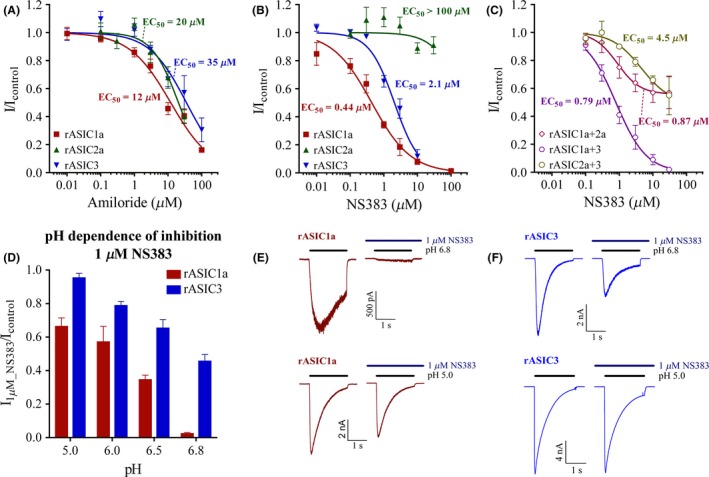Figure 2.

Effects of amiloride and NS383 on homomeric and heteromeric rat acid‐sensing ion channels (ASICs). CHO cells were transiently transfected with cDNA coding for the indicated ASICs, and experiments were performed using conventional whole‐cell patch‐clamp studies with the membrane potential clamped at −60 mV. Rapid (ms scale) pH changes were obtained using a piezo‐controlled θ‐tube as described in Materials. Inhibitory effects of (A) amiloride and (B, C) NS383 at H+‐induced currents from homomeric rat ASIC1a, ASIC2a or ASIC3, or heteromeric rat ASIC1a+2, ASIC1a+3, or ASIC2a+3 plotted as a function of compound concentration. Peak current amplitudes were expressed as fractions of the control peak current amplitude induced by a lowering pH from 7.4 to 6.5 (ASIC1a, ASIC3, ASIC1a+3), or to 5.5 (ASIC1a+2a, ASIC2a+3), or to 4.5 (ASIC2a). Chosen stimulatory pH values approximately represent half‐maximal activation (pH50) at each channel 5. Data points are plotted as mean ± SE, and fitted to the Hill equation using nonlinear regression. Curves represent the fitting, and derived values are seen in Table 1. (D) The inhibitory efficacy of 1 μM NS383 at ASIC1a and ASIC3 showed pH dependency. Data are plotted as mean ± SE from n = 3–22 individual cells. (E, F) Representative traces of ASIC1a and ASIC3 in the presence or absence of NS383. Bars above each trace indicate the pH stimulations or presence of NS383 as indicated.
